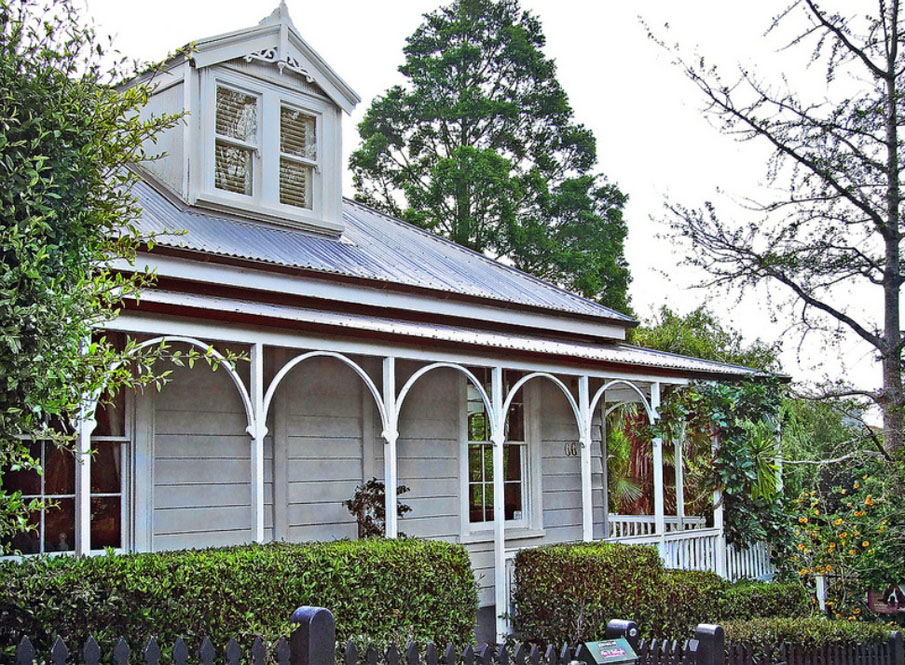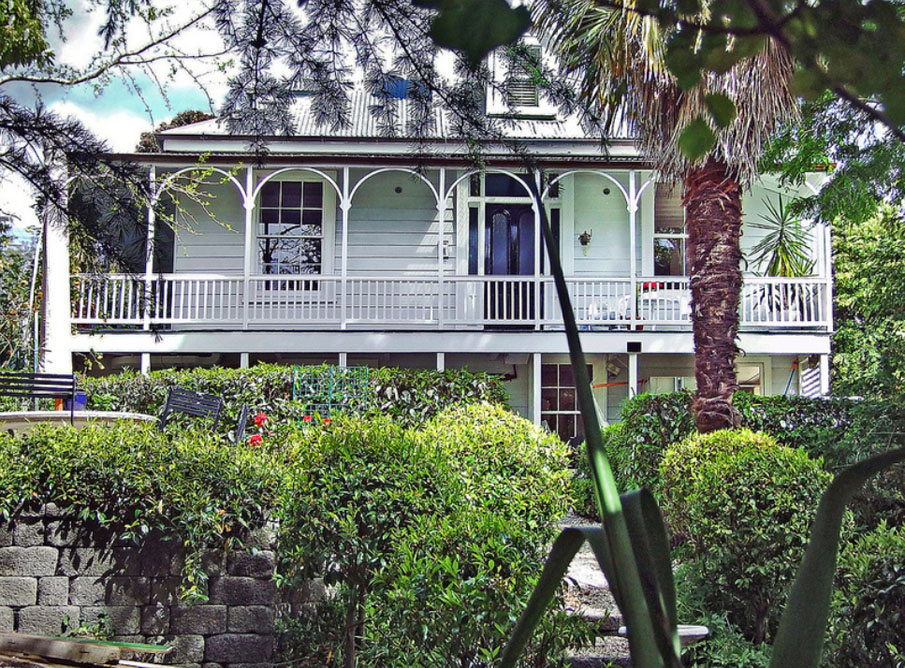Carmichael House was erected overlooking the waterfront at St Georges Bay prior to 1863, and is closely associated with Auckland’s maritime history. The timber residence appears to have been built for Captain Thomas Sparrow Carmichael (1825-1900), an experienced sailor who held a variety of positions at a time when Auckland was developing as the main port in northern New Zealand. Evidently constructed as a family house, the dwelling was occupied by Carmichael’s wife, Marguerite, and their children while he was frequently away at sea. Following his retirement in 1893, it was lived in by a wealthy sailmaker, Richard Bertram. Maritime associations continued until at least the 1930s, when the residence was occupied by a waterside worker. Prior to European arrival, St Georges Bay formed a small inlet between Te Toangaroa (Mechanics Bay) and Taurarua (Judge’s Bay). A pa at Taurarua is believed to have been occupied by Te Waiohua before the area was taken over by Ngati Whatua in the eighteenth century. During the 1840s, Parnell developed as a separate settlement from the nearby centre of government at Auckland although areas such as St Georges Bay housed government officials, including George Clarke, Protector of the Aborigines, and the Colonial Treasurer, George Cooper. In 1860, a plot of land adjoining the main access to the bay - St Georges Bay Road - was purchased by Captain Carmichael. Although still in his thirties Carmichael was a mariner with considerable experience, including as part of the first crew to pass through the Northwest Passage in the Canadian Arctic in 1850-54, for which he had received a medal. At the time of his purchase, Carmichael was master of the Petrel, a 20-ton cutter that is said to have been owned by a northern Maori leader, Te Tirarau, and which provided a weekly service for goods and people between Auckland and Whangarei. Carmichael appears likely to have constructed his house in St Georges Bay at a similar time to his marriage with Marguerite in 1862 and the subsequent birth of their first child. Built on sloping land with views towards the sea, the residence can be described as Georgian in style with a hipped roof and a symmetrical elevation to St Georges Bay Road. The latter elevation was single-storey in height, although the sides and rear of the house incorporated an additional basement level. In 1864, Captain Carmichael was appointed the first Pilot and Harbourmaster at Tauranga, which was being established as a military settlement following the third New Zealand - or Waikato - War (1863-4). During his occupation of this post, Marguerite Carmichael continued to live at the house, with further children being born there. As the family expanded, dormers and a staircase to an attic space may have been created. In 1867, an adjoining allotment on the northern side of the building was also purchased. A large wrap-around verandah of elegant design overlooked the additional land, and also extended along the St Georges Bay Road façade. Following the abolition of his post in 1870, Captain Carmichael returned to occupy the house as his base, and was subsequently involved in the Pacific trade until retiring to Maungakaramea in 1893. The residence was subsequently purchased by a successful tent and sailmaker from Thames, Richard Bertram, who bequested a large amount of money to several organisations in Thames and Auckland including Thames Hospital, the Auckland Jubilee Institution for the Blind, and the Auckland Branch of the New Zealand Society for the Protection of Women and Children. Although the bay’s direct connection with the Waitemata Harbour was removed by reclamation work in the early 1900s, ongoing connections with the maritime industry included occupation by a waterside worker, Louis Olsen, in the first decades of the twentieth century. The house remains in private ownership on a reduced section, having been extensively renovated in the 1980s and 1990s. Carmichael House is aesthetically significant for the visual impact and elegant design of its verandah, and for well-preserved internal elements such as its attic space. The place has historical significance for its lengthy associations with Auckland’s maritime history, encompassing the importance of Maori-owned vessels, coastal trade, the official expansion of government control to new harbours such as Tauranga, and the region’s role in the Pacific trade. It has additional significance for its broader connections with British naval and polar exploration, and its links with the development of St Georges Bay and Parnell during the early colonial period. The place has social significance for its connections with family life in early colonial New Zealand, and particularly a form of household organisation in which husbands were absent from home and family for lengthy periods while engaged in their work.



Location
List Entry Information
Overview
Detailed List Entry
Status
Listed
List Entry Status
Historic Place Category 2
Access
Private/No Public Access
List Number
2637
Date Entered
6th June 2011
Date of Effect
6th June 2011
City/District Council
Auckland Council
Region
Auckland Council
Extent of List Entry
Extent includes the land described as Lot 1 DP 177914 (RT NA109D/16), North Auckland Land District, and the building known as Carmichael House thereon, and its fittings and fixtures. Extent includes the picket fence and gate fronting St Georges Bay Road (Refer to map in Appendix 1 of the registration report for further information).
Legal description
Lot 1 DP 177914 (RT NA109D/16), North Auckland Land District
Location Description
On the southwest corner of the junction between St Georges Bay Road and Ruskin Street
Stay up to date with Heritage this month
